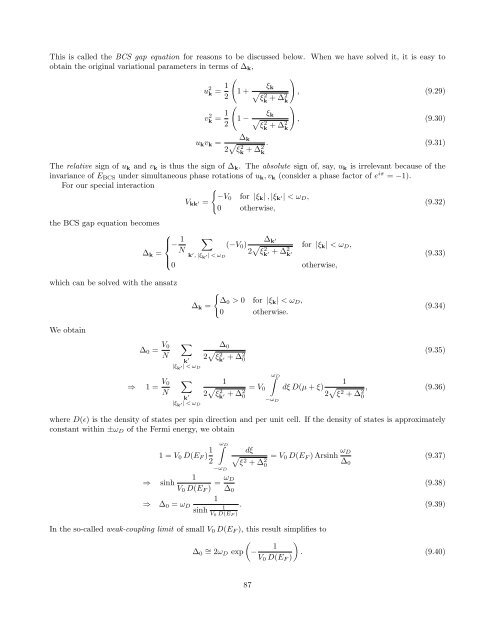Carsten Timm: Theory of superconductivity
Carsten Timm: Theory of superconductivity
Carsten Timm: Theory of superconductivity
Create successful ePaper yourself
Turn your PDF publications into a flip-book with our unique Google optimized e-Paper software.
This is called the BCS gap equation for reasons to be discussed below. When we have solved it, it is easy to<br />
obtain the original variational parameters in terms <strong>of</strong> ∆ k ,<br />
(<br />
)<br />
u 2 k = 1 ξ k<br />
1 + √ , (9.29)<br />
2 ξ<br />
2<br />
k<br />
+ ∆ 2 k<br />
(<br />
)<br />
vk 2 = 1 ξ k<br />
1 − √ , (9.30)<br />
2 ξ<br />
2<br />
k<br />
+ ∆ 2 k<br />
∆ k<br />
u k v k =<br />
2 √ ξk 2 + . (9.31)<br />
∆2 k<br />
The relative sign <strong>of</strong> u k and v k is thus the sign <strong>of</strong> ∆ k . The absolute sign <strong>of</strong>, say, u k is irrelevant because <strong>of</strong> the<br />
invariance <strong>of</strong> E BCS under simultaneous phase rotations <strong>of</strong> u k , v k (consider a phase factor <strong>of</strong> e iπ = −1).<br />
For our special interaction<br />
{<br />
−V 0 for |ξ k | , |ξ k ′| < ω D ,<br />
V kk ′ =<br />
(9.32)<br />
0 otherwise,<br />
the BCS gap equation becomes<br />
⎧<br />
⎪⎨ − 1 ∑<br />
∆ k ′<br />
(−V 0 )<br />
∆ k = N<br />
2 √ for |ξ<br />
ξ 2 k<br />
⎪⎩<br />
′ , |ξ k ′ | < ω D k<br />
+ ∆ 2 k | < ω D ,<br />
′ k ′<br />
0 otherwise,<br />
(9.33)<br />
which can be solved with the ansatz<br />
∆ k =<br />
{<br />
∆ 0 > 0 for |ξ k | < ω D ,<br />
0 otherwise.<br />
(9.34)<br />
We obtain<br />
∆ 0 = V 0<br />
N<br />
⇒ 1 = V 0<br />
N<br />
∑<br />
∆ 0<br />
2 √ ξ<br />
k ′<br />
k 2 + ∆ 2 ′ 0<br />
|ξ k ′ | < ω D<br />
∑ 1<br />
2 √ ξ<br />
k ′<br />
k 2 + ∆ 2 ′ 0<br />
|ξ k ′ | < ω D<br />
∫ω D<br />
= V 0<br />
(9.35)<br />
1<br />
dξ D(µ + ξ)<br />
2 √ , (9.36)<br />
ξ 2 + ∆ 2 0<br />
−ω D<br />
where D(ϵ) is the density <strong>of</strong> states per spin direction and per unit cell. If the density <strong>of</strong> states is approximately<br />
constant within ±ω D <strong>of</strong> the Fermi energy, we obtain<br />
⇒<br />
1 = V 0 D(E F ) 1 2<br />
sinh<br />
∫ω D<br />
−ω D<br />
dξ<br />
√ = V<br />
ξ2 + ∆ 2 0 D(E F ) Arsinh ω D<br />
(9.37)<br />
∆<br />
0<br />
0<br />
1<br />
V 0 D(E F ) = ω D<br />
∆ 0<br />
(9.38)<br />
1<br />
⇒ ∆ 0 = ω D 1<br />
. (9.39)<br />
sinh<br />
V 0 D(E F )<br />
In the so-called weak-coupling limit <strong>of</strong> small V 0 D(E F ), this result simplifies to<br />
(<br />
)<br />
∆ 0<br />
∼<br />
1<br />
= 2ωD exp −<br />
. (9.40)<br />
V 0 D(E F )<br />
87

















